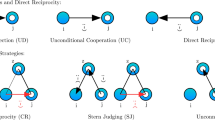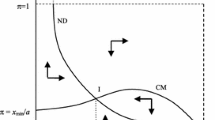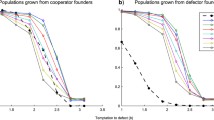Abstract
We study the viability of conditional cooperation in a dynamically evolving social network. The network possesses the small world property, with high clustering coefficient but low characteristic path length. The interaction among linked individuals takes the form of a multiperson prisoners’ dilemma, and actions can be conditioned on the past behavior of one’s neighbors. Individuals adjust their strategies based on performance within their neighborhood, and both strategies and the network itself are subject to random perturbation. We find that the long-run frequency of cooperation is higher under the following conditions: (i) the interaction radius is neither too small nor too large, (ii) clustering is high and characteristic path length low, (iii) the mutation rate of strategies is small, and (iv) the rate of adjustment in strategies is neither too fast nor too slow.









Similar content being viewed by others
Notes
Recently, Wu et al. (2006) consider a model of cooperation on a disordered square lattice, in which some links on the lattice are randomly rewired.
There are some structural differences between a random network and the limiting case of the α-model. However, when k ≫ 1, the limit very closely approximates a random graph. See Watts (1999, pp. 51–52) for details.
In Fig. 3, \(L\left( \Gamma \right) \) and \(C\left( \Gamma \right) \) are normalized by dividing them by \(L\left( \Gamma \right) \) for α = 0 and \(C\left( \Gamma \right) \) for α = 0, respectively.
The fact that the characteristic path length and clustering coefficient cannot be tuned independently is a disadvantage of the α-model. However, varying one of these while holding the other constant would cause the average degree k to change, and this would prevent us from identifying the independent effects of changes in the average degree on the incidence of cooperation.
The notion of hardness allows for a multiperson generalization of the Tit-for-Tat strategy. In a two-person repeated interaction, Tit-for-Tat cooperates in the first period and then simply mimics the last action of the opponent. In a multiperson setting, opponent actions are multidimensional. Hardness allows us to aggregate these actions in a natural way, by identifying the threshold proportion of cooperation in one’s neighborhood that is sufficient to induce a player to cooperate.
This unconditional response is not only realistic but also technically important when we introduce mutation in hardness. For example, without the unconditional response, mutations in hardness in a homogenous neighborhood cannot lead to changes in actions.
The manner in which hardness evolves ensures that \(h_{i}\left( t\right) \in \left[ 0,1\right] \) for all t.
An important determinant of real world social networks is the endogenous formation and breakage of links (Jackson and Wolinsky 1996). One might expect that individuals would seek to form links with those with a higher propensity to cooperate, and break links with defectors. These effects, which we neglect here, would make it easier for cooperative clusters to form and spread. We show that despite the unbiased formation and breakage of links, the incidence of cooperation can be significant.
Note that mutations in the propensity to cooperate are sufficient to ensure that there are no absorbing states, so random rewiring of the network is not necessary for this purpose. We allow for changes in network structure because it occurs in practice, and is likely to affect the extent to which cooperation can persist in the long run.
The simulation was run for 100,000 periods and first 30,000 observations deleted. There are 300 periods between adjacent data points in the figure, to smooth out extreme short run volatility.
Eshel et al. prove that the level of cooperation must lie between 60% and 100%. It is interesting that we find cooperation to lie roughly at the midpoint of this range.
In a regular network with degree k, a large enough cluster of cooperators survives in the steady state if the benefit-cost ratio β exceeds than 4k/(3(k/2) − 1); see Jun and Sethi (2007). Accordingly, we choose a value higher than this threshold.
For each of the following four cases, we change only one parameter of the model, while fixing all other parameters at the values of Section 4.2.
Although not shown, the frequency is almost zero for values of k ≥ 34.
The matrix is based on parameter values n = 1,000, k = 16, α = 7, δ = 0.85, ε = 0.005, p = 10 − 10, β = 4.783, ω = 2, T = 100,000, and t = 30,000.
References
Abramson G, Kuperman M (2001) Social games in a social network. Phys Rev E 63:030901-1-4
Albin PS, Foley DK (2001) The co-evolution of cooperation and complexity in a multi-player, local-interaction prisoners’ dilemma. Complexity 6:54–63
Axelrod R, Hamilton WD (1981) The evolution of cooperation. Science 211:1390–1996
Barabási AL (2003) Linked: how everything is connected to everything else and what it means. Plume, New York
Bergstrom T, Stark O (1993) How altruism can prevail in an evolutionary environment. Am Econ Rev Pap Proc 83:149–155
Cohen M, Riolo R, Axelrod R (1999) The emergence of social organization in the prisoner’s dilemma: how context-preservation and other factors promote cooperation. Working paper 99-01-002. Santa Fe Institute
Eshel IL, Samuelson L, Shaked A (1998) Altruists, egoists, and hooligans in a local interaction model. Am Econ Rev 88:157–179
Fehr E, Gächter S (2000) Fairness and retaliation: the economics of reciprocity. J Econ Perspect 14:159–181
Jackson MO, Wolinsky A (1996) A strategic model of social and economic networks. J Econ Theory 71:44–74
Jun T, Sethi R (2007) Neighborhood structure and the evolution of cooperation. J Evol Econ 17:623–646
Kim BJ, Trusina A, Holme P, Minnhagen P, Chung JS, Choi MY (2002) Dynamic instabilities induced by asymmetric influence: prisoner’s dilemma game in small world networks. Phys Rev E 66:021907-1-4
Kirchkamp O (1995) Spatial evolution of automata in the prisoner’s dilemma. Discussion paper B-330. Rheinische Freidrich Wilhelms Universität Bonn
Lindgren K, Nordahl MG (1994) Evolutionary dynamics of spatial games. Physica D 75:292–309
Masuda N, Aihara K (2003) Spatial prisoner’s dilemma optimally played in small-world networks. Phys Lett A 313:55–61
Nowak MA, May RM (1992) Evolutionary games and spatial chaos. Nature 359:826–829
Nowak MA, May RM (1993) The spatial dilemmas of evolution. Int J Bifurc Chaos 3:35–78
Szabo G, Fath G (2006) Evolutionary games on graphs. arXiv:cond-mat/0607344v2
Szabo G, Vukov J (2004) Cooperation for volunteering and partially random partnerships. Phys Rev E 69:036107-1-7
Trivers RL (1971) The evolution of reciprocal altruism. Q Rev Biol 46:35–57
Watts D (1999) Small worlds. Princeton University Press, Princeton
Watts D, Strogatz SH (1998) Collective dynamics of ‘small-world’ networks. Nature 393:440–442
Wu Z, Xu X, Huang Z, Wang S, Wang Y (2006) Evolutionary prisoner’s dilemma game with dynamic preferential selection. Phys Rev E 74:021107
Acknowledgements
The first author acknowledges financial support from Kyung Hee University (KHU-20050406). We thank Beom Jun Kim for help with simulations and for comments on an earlier draft, and an anonymous referee for a number of helpful suggestions.
Author information
Authors and Affiliations
Corresponding author
Rights and permissions
About this article
Cite this article
Jun, T., Sethi, R. Reciprocity in evolving social networks. J Evol Econ 19, 379–396 (2009). https://doi.org/10.1007/s00191-008-0117-5
Published:
Issue Date:
DOI: https://doi.org/10.1007/s00191-008-0117-5




